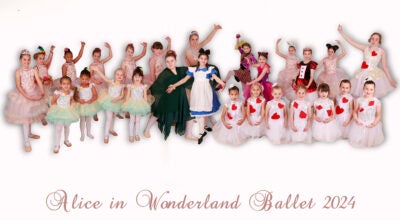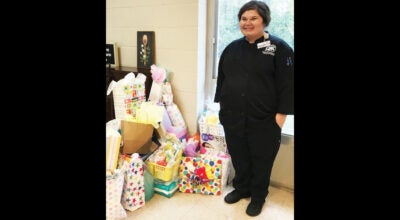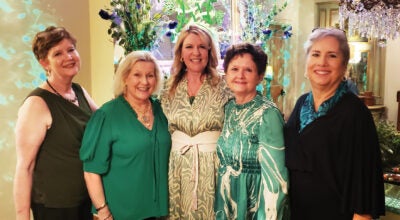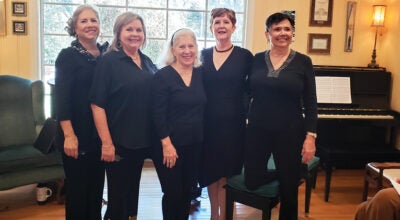Recognizing Speech and Hearing Month
Published 8:32 pm Saturday, May 14, 2016
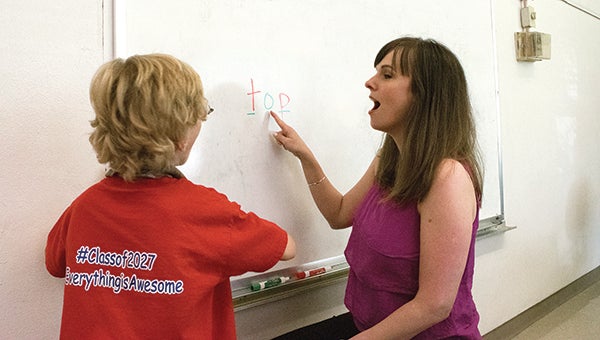
Photo by Julia Miller / Rachel Powell, a speech language pathologist at Mamie Martin, helps one of her students, JT Pendley, sound out “top” Tuesday afternoon. Powell recently received the MHSA Honors of the Association award.
Speech language pathologists are who we turn to when we struggle with our Rs, Ss and Ls, but what most people don’t realize is that these dedicated workers help improve much more than enunciation.
But with May being National Speech and Hearing Month, those in the field hope to spread some light on the subject.
Rachel Powell, a speech language pathologist at Mamie Martin Elementary School, said her own passion lies within the literacy niche of her profession.
“It correlates because language is the foundation for literacy,” she said.
In fact, Powell’s doctorate is in literacy and language disease and disorder. She not only works with students, but she works with teachers in the district to ensure reading is being taught well. She is part of a task-force with the district to help identify those who may struggle with the third-grade reading gate as well as provide intervention protocols.
“I use data to identify instructional needs across the school as well as individual needs,” she said.
At the cornerstone of literacy is vocabulary, and it can have a substantial impact on reading comprehension. Unfortunately, Powell said vocabulary is greatly impacted by socio-economic backgrounds. Children of a middle-class background can know as many as 10,000 more words than those from a low-income background.
“Vocabulary content knowledge is the most critical area,” she said.
Powell is also active in Mississippi Speech-Language-Hearing Association where she was recently recognized for her efforts with the Honors of the Association award, given to just one person a year. She was nominated by her peers based on her contributions to the discipline of communication sciences and disorders and is the highest honor the Mississippi Speech-Language-Hearing Association bestows.
Through the group, she has become an advocate at both the state and national level for her discipline.
“[In the beginning] I wouldn’t have expected we’d have to advocate for ourselves as much,” she said.
Powell said part of working with legislators is educating them on what speech language pathologists can accomplish. In addition to pronunciation and literacy, these professionals help with swallowing, assist adults who have strokes and work with those who stutter or have voice issues. From birth to old age and from special needs to the average, speech language pathologists are capable of assisting anyone.
Powell was able to get to her position by earing a bachelor’s and master’s at the University of Southern Mississippi and a doctorate from Louisiana State University in 2009. More importantly, her mother pointed her to the right path.
“My mom was a reading specialist, and she told me speech language pathology was good field for me,” she said citing her love of language and reading. “Turns out she was right.”
Although Powell’s first class at Mamie Martin is graduating from Brookhaven High School this year, her passion for the subject and her dedication to her students hasn’t faded.
Powell is married to Mike Powell, a coach and teacher at Brookhaven High School, and they have three children, Kennedy, 8, Cecile, 3, and James, 5 months.
How does your child hear and talk?
Children develop at their own pace. This checklist shows the average ages when most children have developed these skills. Your child might not have all skills until the end of the age range. All information is from the American Speech-Language-Hearing Association.
Birth to 3 months
• Startles to loud sounds
• Quiets or smiles when you talk
• Seems to recognize your voice and quiets if crying
• Makes cooing sounds
• Has different cries for different needs
• Smiles at people
• Moves eyes in direction of sounds
4 to 6 months
• Notices toys that make sounds
• Pays attention to music
• Responds to changes in tone of your voice •Coos and babbles when playing alone or with you
• Makes speech-like babbling sounds, like pa, ba and mi
• Giggles and laughs
• Makes sounds when happy or upset
7 months to 1 year
• Turns and looks in direction of sounds
• Looks when you point
• Turns to own name when you call
• Recognizes words for familiar objects and people, like cup, truck, juice and daddy
• Begins to respond to simple words and phrases, like “No,” “Come here” and want more?”
• Plays games with you, like peekaboo and pat-a-cake
• Listens to songs and stories for a short time
• Babbles longer strings of sounds, like mimi upup babababa
• Uses sounds and gestures to get and keep attention
• Points to objects and shows them to others
• Uses gestures like waving bye-bye, reaching to be picked up or shaking head no
• Imitates different speech sounds
• Says one or two words, like hi, dog, dada, mama or uh-oh, around first birthday. All words may not be clear
1 to 2 years
• Points to a few body parts when you ask
• Follows 1-part directions, like “Roll the ball” or “Kiss the baby.”
• Understands simple questions, like “Who’s that?” and “Where’s your shoe?”
• Listens to stories, songs and rhymes for a longer time.
• Points to pictures in books when you name them.
• Uses a lot of new words
• Uses p, b, m, and w in words
• Starts to name pictures in books.
• Asks what, who and where questions, like “What’s that?” “Who’s that?” and “Where’s kitty?”
• Puts two words together, like “More apple,” “No bedtime” and “Mommy book”
2 to 3 years
• Understands opposite words, like go-stop, big-little and up-down
• Follows 2-part directions, like “Get the spoon and put it on the table.”
• Understands new words quickly
• Has a word for familiar people, places, things and actions
• Talks about things that are not in the room
• Talks during pretend play, like saying beep-beep when moving cars
• Uses k, g, f, t, d and n in words
• Uses words like in, on and under
• Asks why?
• Familiar people understand your child’s speech
• Puts three words together to talk about and ask for things. May repeat some words and sounds
• Responds when you call from another room
3 to 4 years
• Understands words for some colors, like red, blue and green
• Understands words for some shapes, like circle and square
• Understands words for family, like brother, grandmother and aunt.
• Answers simple who, what and where questions
• Says rhyming words, like hat-cat and silly-billy
• Uses pronouns, like I, you, me, we and they
• Uses some plural words, like toys, birds and buses
• Most people understand your child’s speech
• Asks when and how questions
• Puts four words together. May make some mistakes, like “I goed to school.”
• Talks about what happened during the day. Uses about four sentences at a time.
4 to 5 years
• Understands words for order, like first, next and last
• Understands words for time, like yesterday, today and tomorrow
• Follows longer directions, like “Put your pajamas on, brush your teeth and then pick out a book.
• Follows classroom directions, like “Draw a circle on your paper around something you eat.”
• Understands most of what is said at home and at school
• Says all speech sounds in words. May make mistakes on sounds that are hard to say, like l, s, r, v,z, j, ch, sh and th
• Responds to “What did you say?”
• Talks without repeating words or sounds most of the time.
• Names letters and numbers
• Uses sentences that have more than one action word, like jump, play and get. May make some mistakes, like “Zach gots two video games, but I got one.”
• Tells a short story
• Keeps a conversation going
• Talks in different ways depending on the listener and place. May use short sentences with younger children or talk louder outside than inside.


